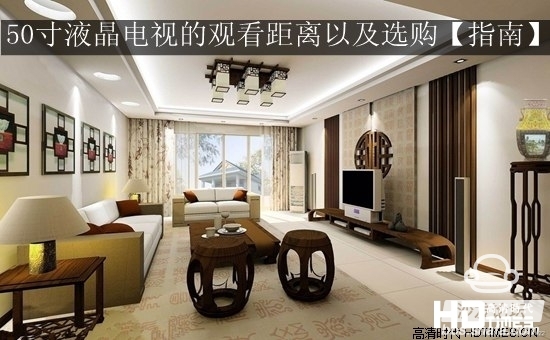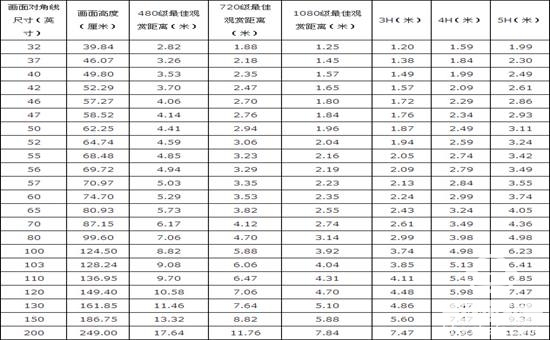
Due to the structure of the human eye, we can only see the range of about 150 degrees in front of the eye and 140 degrees in the longitudinal direction. Therefore, watching TV is as simple as watching TV at a viewing angle of 40 degrees above and 40 degrees, and around 60 degrees. This look and feel is already fine. According to current television, almost all LCD TVs have a 16:9 widescreen design. If a wide screen is close to the camera, it will be distorted in the left and right visual range, and the viewing effect cannot be optimized. .
Best viewing distance = LCD diagonal length × 2 (this is the closest viewing distance) / × 3 (this is the farthest viewing distance)
Maximum TV size (inch) = viewing distance (cm) ÷ 3.736
The minimum TV size (inch) = viewing distance (cm) ÷ 6.227
Xiao Bian has compiled the best viewing distance for each size for everyone:

50-inch LCD TV purchase
1. According to the living room area to buy a 50-inch LCD TV The bigger the TV screen, the corresponding viewing distance will increase, a 50-inch LCD TV, placed in a small living room, I am afraid it looks asymmetry, not even display . The most reasonable distance to watch TV is to ask people to see every corner of the TV without turning their eyes and head. The best viewing distance is about 4.5 meters for a 50-inch LCD TV. Left and right, such a distance is like a fantasy in a small living room.

2. According to the cost-effective purchase of 50-inch LCD TVs from ancient times to the present, commodity prices are the absolute factors affecting the transaction rate, 50-inch LCD TVs is no exception, so no matter what you buy, most consumers will not directly ask the goods How about quality, but first ask how the price. It can be seen that the cost-effectiveness of the importance of a product, often see a lot of TV brands discounted activities, seemingly cut the price of thousands of dollars, but the actual price is still prohibitive, a 50-inch LCD TV size screen Flat-panel TVs, basically all belong to the brand's high-end products, prices are basically above 10,000 yuan.

3. According to the 50-inch LCD TV accessories to buy Many of the family buying flat-panel TVs, the TV is hung on the wall, so not only beautiful, but also save space. However, a 50-inch LCD TV is said to have a weight of tens of kilograms. A heavier weight may reach 50 kilograms. Its weight is equivalent to the weight of four 1.5-hp split air conditioners. If the installation is not good, the consequences are very serious.
However, to install and hang a good 50-inch LCD TV, its accessories requirements are very high, especially the quality of the wall bracket must be better, and must undergo rigorous calculations and repeated testing, both in terms of strength and durability can be achieved Required.
Antenk DVI Series Digital Video Interface connectors are the standard digital interface for flat panels, video graphics cards, monitors and HDTV units. This series includes DVI-D (Digital), DVI-A (Analog) and DVI-I (Integrated Digital/Audio). Their unique crossing ground blades provide high speed performance at low cost. They are available in Straight or Right Angle PCB mount receptacles and mating male cable connectors. They support a data transfer rate of 4.95Gbps with a dielectric withstanding voltage of 500VAC. Each version features our specially designed contacts which improve signal performance and a zinc alloy shield that reduces electromagnetic interference (EMI).
Digital Visual Interface Cable Connectors
DVI ConnectorWith the advent of technologies such as DVD players, high-definition televisions, and even digital cable, the need for more advanced cables and connectors has increased. Digital Visual Interface (DVI) is one response to the growing need for interconnected systems, enabling digital systems to be connected to an array of displays. Yet DVI cables and connectors can also be complicated, and may lead to confusion between High Definition Multimedia Interface (HDMI) and DVI. Although the two systems have much in common, they service different niches of digital technology.
Digital Visual Interface
Older systems aren`t necessarily outdated systems. Although DVI preceded HDMI, it`s still widely used in both business and domestic settings. DVI connectors are designed to handle digital data transmission, incorporating three transmission channels in every connector link. The maximum bandwidth for data transfer is 165 megahertz, which is enough to relay up to 165 million pixels per second. Data is encoded for effective transfer, but a single link can handle around 4.95 gigabits per second of information. Double links can handle twice that amount.
Because a DVI cable carries information over a 165 megahertz bandwidth, complete digital resolution can be obtained. Using double link connectors increases the speed of transmission, but requires another cable. However, not many devices depend solely on a double link DVI, so this technolgy can be used on an as-desired basis.
Types of DVI Connectors
There are three general categories of DVI cable connectors: DVI-Digital (DVI-D), DVI-Integrated (DVI-I), and DVI-Analog (DVI-A). However, most connectors fall into one of the first two groups.
A standard DVI connector is 37 mm wide and has 24 pins, 12 of which are used for a single link connection. When analog is involved, four additional pins are needed to support the additional lines of an analog signal. It is not possible to cross from a digital source to an analog display or vice versa. In those instances, an integrated connector is probably the best option. There are five common types of DVI connectors.
DVI-I Single Link
This kind of connector has three rows, each with six pins. There are two contacts. Because the connector is integrated, it can be used with both analog and digital applications.
DVI-I Dual Link
A DVI-I dual link connector can also be used with both digital and analog applications, but is configured with more pins to accommodate a dual connection. There are three rows with eight pins each, as well as two contacts.
DVI-D Single Link
Specifically designed for digital applications, a DVI-D single link connector has three rows of six pins, and looks much like a DVI-I single link connector. However, a DVI-D connector has no contacts.
DVI-D Dual Link
Also made specifically for digital applications, a DVI-D dual link features more pins (three rows of eight) for dual connections. Like a DVI-D single link, a DVI-D dual link connector has no contacts.
DVI-A
This particular type of connector can only be used for analog applications, and has three rows of pins. One row has five pins, one has four pins, and the last row has three pins. Like single link connectors, a DVI-A link connector has two contacts.
Dvi Connector,Dvi Female Connector,Dvi Hdmi Connectors,Vga Dvi Connector,Digital Visual Interface Cable Connectors
ShenZhen Antenk Electronics Co,Ltd , https://www.antenk.com
